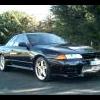Turbo Failure On Rb26
Announcements
-
Similar Content
-
Latest Posts
-
Hello, after engine rebuild(new cylinder liners and piston rings, arp headstuds, metal cometic tripple layer gasket, all new main/rod bearings) and roughly 100km made I did measure compression and it’s (1-6) - 80, 60, 90, 120, 110, 135. It’s rb25det series 1 - hydraulic lifters. Measured on cold engine. Didn’t check on hot due to overall car problems such as broken 3rd gear, idle issues, misfire etc. I did smoke test only on 2nd and 5th cylinder bcs soldering iron used with this method broke itself. So after setting cams to side - side 90 left/right angle I can see smoke coming off from intake manifold and turbo exhaust flange. 5th didn’t notice any smoke. Shop did head, valve etc job but I assemble it by myself. So I thinking about lifters. I don’t remember if they were soft or not it was long time ago. In my opinion I didn’t bleed them and they can be opened more than they should be. Can it be more likely possible? Or timing can be off by 1 teeth and can cause such weird compression? But if timing would be out wouldn’t it be like such big difference across all cylinders? Please help I’m so sad it happened.
-
Hey, yeah I really like the color. Only paint I'd rather have is KN6, but those are expensive. Right now I'm trying to get the car to the point where I can get it tuned to 370hp so the whole setup can be driven legally, and pass the next inspection that is already due anyway. Beyond that lots of rust fixing I'm afraid, winter project is most likely going to be a front end teardown and fixing the strut tower rust. I know these can be driven daily but I don't think I will do so anytime soon. Will post a build thread soon with a list of issues and futute plans. Cheers
-
By codygrimm27 · Posted
Wanted to reply to this topic. I'm in the somewhat same boat with our Stagea. I'm trying to install a different rear diff. The Stagea/Skyline uses mounts on top of the rear diff for the ATTESA pump. Any way you can relocate the pump? I did find this kit https://theskylineshed.com/products/nissan-oem-attesa-mounting-kit-to-suit-r32-r33-r34 -
By codygrimm27 · Posted
So here's the deal, my wife picked up an S2 AWD Stagea. Super cool, clean car. Looks like the owner in Japan went track spec as it's got some heavy modifications including Exedy twin disk, tension rods, coilovers, GTR brakes, oil cooler & a Nismo 2 way rear diff. Now, cool mods for sure. But, she is just using this as a casual daily driver. The 2 way rear is AGGRESSIVE. It also has solid subframe bushings & poly diff bushings. So that doesn't help either. So far I've tried changing the diff fluid to the correct fluid. Even tried a little friction modifier. No help. This thing clunks, skips the tires & has some slight whine/NVH when driving. Might sound like I'm being picky, but just trying to find a better solution. Here in the states, it's impossible to find a Stagea rear diff. No luck. I do have a 300zx non-turbo diff. Same ratio, 5 bolt axles. On the Stagea, you need both front & rear diff ratios to match. This car is a 4.083. I'd like to just swap a normal rear diff into this thing. Nothing fancy. Even open diff is fine. She's not tracking the car LOL The difference is that the ATTESA pump mounts to the top of the rear diff. There are 3 total mounting points for the pump on top of the diff. With all this being said, what would be the best way to go about this? I could remove the Stagea diff & see if I could get somebody to possibly weld the 3 tabs/mounting points onto the 300zx diff so we could mount the pump on the 300zx diff. I could swap the internals from the 300zx into the Stagea diff but this is not in my comfort zone. Is it possible to mount the ATTESA pump to the underside of the car? Sorry for the paragraph. Just trying to figure out how to go about this. Any help is much appreciated! Stagea Differential - Note two top tabs, one bolt hole for ATTESA pump mounting 300zx Diff - No mounting tabs Also found this mounting kit ?? https://theskylineshed.com/products/nissan-oem-attesa-mounting-kit-to-suit-r32-r33-r34








Recommended Posts
Create an account or sign in to comment
You need to be a member in order to leave a comment
Create an account
Sign up for a new account in our community. It's easy!
Register a new accountSign in
Already have an account? Sign in here.
Sign In Now